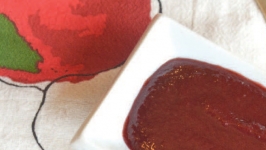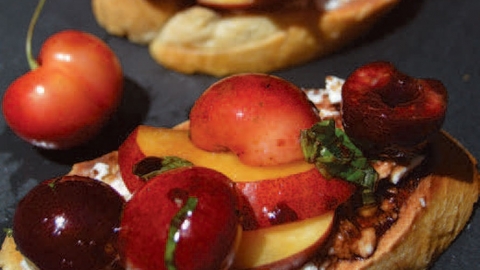A reward for PATIENCE
THE SHORT SEASON THAT INVOLVES A LONG WAIT
“Cold is the key to perfect pitting. A cold cherry will retain its shape and make pit removal easier.”
— Kristin Seaquist, Seaquist Orchards
Four years ago, I wrote my first article for Edible Door, sharing my love affair of cherries with our readers. Although I am a Door County “transplant,” it didn’t take long to develop a love for
those little tart red beauties that appear throughout our county for an all-too-short three-week harvest starting around mid-July.
If you’re a pie baker, cherry season is an exciting time. I may be biased, but our tart Montmorency cherries make the most delicious pie in the world. Though frozen cherries are available year-round, it’s those fresh summer gems that bakers wait literally all year to savor. The time spent individually pitting those cherries is well-spent when your fork hits that oversized piece of the season’s first pie.
But if you are in love with cherries as much as I am, don’t restrict your cherry love to simply pie and to just Montmorency cherries. Although Montmorency cherries make up the vast majority of our county’s cherry crop, there are other varieties of cherries that you will find at area farm stands. And though they make a delicious pie, there are many other ways to incorporate the red stone fruit into everything from breakfast dishes, appetizers and even condiments.
But first things first; start by getting to know our local fruit.
KNOW YOUR CHERRIES
“Ninety-nine percent of our trees are Montmorency,” said Kristin Seaquist, co-owner of Seaquist Orchards, the state’s largest producer of cherries. “But we have some sweet cherry trees that come to har- vest earlier.”
They include Queen Anne, Cavalier and Danube. These sweet cher- ries make for delicious eating raw, but should be avoided when bak- ing. Tart cherries hold their shape better when baked (no one loves a gloppy cherry pie), and their tartness allows bakers to adjust the sweetness of a recipe to suit their tastes.
You’ll find a few other tart cherry varieties besides Montmorency. The Richmond cherry is a darker red tart cherry that is ready for harvest about one week before the Montmorency variety. Coming up at the end of the cherry harvest is the Balaton. Also slightly darker in color, the Balaton
cherry has a higher sugar content than its more familiar cousin.
PICKING AND STORING
One of the simple pleasures of a visit to Door County is picking your own cherries at one of the area’s many orchards. But how do you know if a cherry is ready to add to your bucket?
“If the cherry doesn’t come easily off the tree, it isn’t ready,” ex- plained Seaquist. “You shouldn’t have to tug at it. If you give it a gen- tle pull and it comes off, the cherry is ripe.”
Come equipped with a cooler and some ice water. Seaquist recommends removing the cherries from the carton or bucket and placing them directly in the cold icy water. Since cherries are highly perishable, transporting the cherries this way keeps them nice and plump during their journey home. Remove them from the ice water and dry them off. Immediately place them in a Ziploc bag and store in the refrigerator until ready to use.
PIT TIPS
One of the more time-consuming tasks of working with fresh cherries is removing the pits.
The traditional method of pitting cherries is with a hairpin poked into the bottom of the cherry to pop out the pit. For those of us not
trained in hairpin pitting, try one of the many pitting gadgets that are available. Small countertop pitters with a hopper on top and a box on the bottom make pitting easier for a novice. A plunger pushes the pits into the box and the cherries fall from a chute into a waiting bowl.
Another easy cherry pitter is the push-button cher- ry pitter. Developed in Sturgeon Bay in the 1950s by the Mark Schlise family, this easy-to-use pitter has helped many a baker process buckets and buckets of cherries. The pitting system consists of a plunger attached to a jar top that can be easily attached to al- most any glass canning jar. Visit any farm market in the county and you’ll see push-button pitters being sold next to the stand filled with all those freshly picked cherries.
One important key to pitting, no matter what method used, is the temperature of the cherry. “Cold is the key to perfect pitting. A cold cherry will retain its shape and make pit removal easier,” Seaquist said.
MISSED THE SEASON? NO PROBLEM
The fresh tart cherry season is one of the shortest seasons for any fruit. Cherries are ready to harvest approximately six weeks after the trees blossom, making the start of the season somewhere during the first few weeks of July and ending in early August.
But if you miss fresh cherry season, don’t despair. A mere 1 percent of the cherry crop is sold fresh. The majority is processed to be used in pie filling, jams, preserves, or as a dried product so that the tart goodness of the fruit can be enjoyed throughout the year.
EXPAND YOUR RECIPES BEYOND PIE
Although cherry pie has been named as the No. 1 favorite pie in the world (yes, our little red cherries have pushed apples to No. 2), there are many more ways to enjoy our county’s favorite fruit.
For an appetizer, try using some of the sweet cherry varieties with locally-produced goat cheese to make some tasty crostini. Finish with a drizzle of balsamic vinegar (you’ll find cherry balsamic vinegar at many markets in the area) and a few chopped fresh mint leaves, and you have a perfect accompaniment with a glass of wine as you enjoy a Door County sunset.
Get out that cast-iron skillet and put together an easy cherry cla- foutis. This classic French dish is similar to a Dutch pancake. Serve the clafoutis directly from oven to table as a cherry start to your day for breakfast or as a sweet tart conclusion to a casual summer meal.
If you’re like me and can’t pick just one bucket of fresh cherries, you’ll be looking for recipes that let you enjoy these tart treasures all year long. Look no further. Get your canning pot out and make a batch (or two or three) of tart cherry ketchup. With a mixture of tart cherries, a little added sweetness and a surprise addition of spices, you will never buy another one of those plastic bottles of the tomato stuff. Plus, it will make that long wait for cherry season a little bit easier










